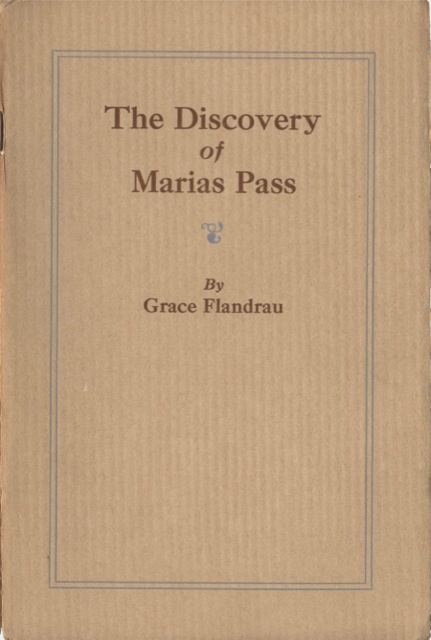On July 21, the Upper Missouri Special went to the railway’s summit on the southern boundary of Glacier Park where the GN had commissioned the sculptor, Gaetano Cecere, to do a statue of John F. Stevens. Then just 31 years old, Cecere went on to do sculptures for the U.S. Capitol, Smithsonian, and 1939 New York World’s Fair.

The statue of John Stevens has been moved a short distance from its original location, but former GN–now BNSF–tracks are still visible in the background. Flickr photo by jvstin; click image for a larger view.
Stevens, of course, was the engineer who had followed a branch of the Marias River to Marias Pass, thereby locating the Great Northern’s route across the Rockies. The statue was unveiled by John F. Stevens III, the engineer’s grandson. Speeches were given by Supreme Court Justice Pierce Butler and the president of the American Society of Civil Engineers, Robert Ridgeway. The engineer himself (who lived until 1943) was on hand to “graciously and gracefully respond.” In between speeches, the Great Northern Songsters sang “Land of Hope and Glory,” “The World Is Waiting for the Sunrise,” and “I’ve Been Working on the Railroad.”
“The many years which I spent in the service of the Great Northern Railway, years which covered the best part of my active life, were by far, to me at least, the most satisfactory of my career,” he said. “The knowledge. . . which I gained from that master mind, James J. Hill, has been, since I first met him, the dominant influence in my working career.” He went on to say, “It is a common truism that corporations have no souls. But I think that you will all agree with me that one corporation has a soul, and that it is wonderfully shown here today, and besides soul, this one has lasting memory.”
People rarely erect statues to living persons, but Stevens was Ralph Budd’s mentor and in a very real sense Budd owed his current job to the senior engineer. Born in 1879 on an Iowa farm, Budd managed to get a degree in civil engineering by the time he was 19 years old and immediately went to work for the Chicago Great Western. Four years later, in 1902, he took a job helping the Rock Island construct its Kansas City-St. Louis line.
Budd met Stevens, who was 26 years older, a year later when the latter became chief engineer of the Rock Island Railroad. Two years later, Theodore Roosevelt (on James J. Hill’s recommendation) hired Stevens to take over construction of the Panama Canal, and Stevens brought Budd along with him. If the palindrome “A man, a plan, a canal — Panama!” is based on anyone, it is Stevens, who more than anyone was responsible for the canal’s successful completion.

According to reports of those who went on the Upper Missouri Expedition, one of the essays distributed by the Great Northern was The Discovery of Marias Pass. That’s the name on the cover, but on the title page it’s called “The Story of Marias Pass.” Grace Flandrau’s essay describes several efforts to find Marias Pass, concluding with John Stevens’ successful attempt in 1889, which was thrilling mainly because his explorations took place during a severe winter blizzard. “The mosquitoes didn’t bother me,” he later noted. Click image to download an 7.8-MB PDF of this booklet.
When he accepted the job, Stevens told Roosevelt he would only work until he was satisfied that the canal could or could not be completed. While Budd oversaw reconstruction and relocation of the Panama Canal Railroad, which was essential for both construction and maintenance of the canal, Stevens was fighting disease-spreading mosquitoes and deciding whether to build a water-level canal or a high-level canal with locks. Having solved the major problems facing builders, Stevens left before the canal was finished, angering Roosevelt, who later refused to give Stevens any credit for the crucial work he did on the canal. Years later, Stevens nonetheless said Roosevelt and James J. Hill were the two biggest influences in his life.
After leaving Panama, Hill hired Stevens to manage the newly built SP&S Railway, and Stevens put Budd to work building SP&S subsidiary Oregon Trunk from the Columbia River to Bend, which was the only Hill-built railroad that had a last spike ceremony. Impressed with Budd’s work, Hill brought the 32-year-old engineer to St. Paul to be his assistant. Before he died in 1916, Hill privately told his son, Louis, that he should make Budd the next president of the Great Northern, which he did in 1919. Just 40 years old, Budd was the youngest railroad president at the time and one of the youngest in history. (Louis Hill himself was not quite 35 when he first became president of the GN).
For Budd, then, the dedication of the statue at Marias Pass was the climax of the tour and an opportunity to honor his old friend. It wasn’t the first opportunity. Just four months before, the American Association of Engineering Societies awarded John Stevens the John Fritz Medal, the highest award given to an engineer. Previous awards had been given to George Westinghouse, Alexander Graham Bell, Thomas Edison, Alfred Nobel, Orville Wright, and Guglielmo Marconi. Budd, who would get his own Fritz medal in 1941, gave the presentation speech lauding Stevens’ efforts in locating the Great Northern line and building the Panama Canal.
After dedicating the statue, the train went on to West Glacier and expedition member Charlie Russell hosted a reception for the group at his cabin near Lake MacDonald. They then had dinner at Lake MacDonald Lodge and, after another night at Glacier Park Lodge, most boarded the train to return to St. Paul the next day.
